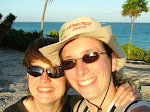




The agency picked us up at our hotel and drove us to the port. We have been surprised to see how busy this port is, lots of boats going with tourists to the islands. We got on the boat and met our guide and the rest of the group (13 other tourists from England, the States, Ireland, Canada and Netherlands). It took us 30min to reach the Uros Islands, the boat going along a canal boarded by the plants the Uros use to make their floating islands with. We found those islands very touristy, too touristy! The Uros wait for the boats of tourists all dressed up in their traditional clothes, welcome the tourists and then go back to their stands to sell souvenirs. Our guide gave us some information about the lake (altitude 3809m, length 204km, width 65km, depth 284m). He also explained to us how the Uros build their boats and their floating islands….a boat lasting only for a year. We then had time to visit the houses, take some pictures and buy some souvenirs. Afterwards we got on one of their boat to go to another island (S/5) before getting back on the agency boat to go to Amantani. It took us 3h to reach Amantani Island, a small island of a total 9.28 km2. Hermania welcomed us at the port and showed us the way to her family house. She was dressed in the traditional costume of her community, but got changed as soon as she arrived at home! She introduced us to her husband and her 4 children, 3 boys and 1 girl. We offered them presents; rice and sweets...the sweets being appreciated by all the family! Afterwards we sat in the kitchen while she prepared lunch for us. We were surprised of the conditions they are living in. There is no flooring in the kitchen and the smoke from the fire made the walls black. The fireplace is very basic, the only furniture are some shelves, a table and 3 benches. The meal was very good, a quinoa soup and then boiled potatoes with grilled cheese. The family also had lunch but none of them sat at the table, except one of the boys who accepted to seat with us at the table (later we have been told by our guide that people don’t eat at the table and that the table is made only for tourists). After the meal we met up with our group and the guide gave us some more information about the island. He explained that 9 communities live on the island and that there are 2 primary schools and 1 high school. The first tourists came on the island only in 1982. Then we walked up to the highest point of the island 4200m, where there are some Inca's ruins, well the view on the lake at the top is beautiful but the ruins are nothing special. We came back to the main place where one of the kids from the family was waiting for us to show us the way back to the house. We had to wait nearly two hours for having dinner....Gosia got very cold and bored. We had dinner in the kitchen but as there was no fire in the fireplace we understood that they have another kitchen where they cooked our dinner...we were eating in the kitchen for the tourists! We had a chat with the 17 year old girl about the life on the island. She told us that there was no job on the island so she was working with her parents. She had been to Puno but just to buy clothes and food, twice a year. Her life looked so monotone and boring to us! She told us that the life is hard but very peaceful on the island. After dinner we were given traditional costumes for the party, so we got all dressed up and went to the party with our family. All the tourists and families danced along the traditional music played by a local band.
